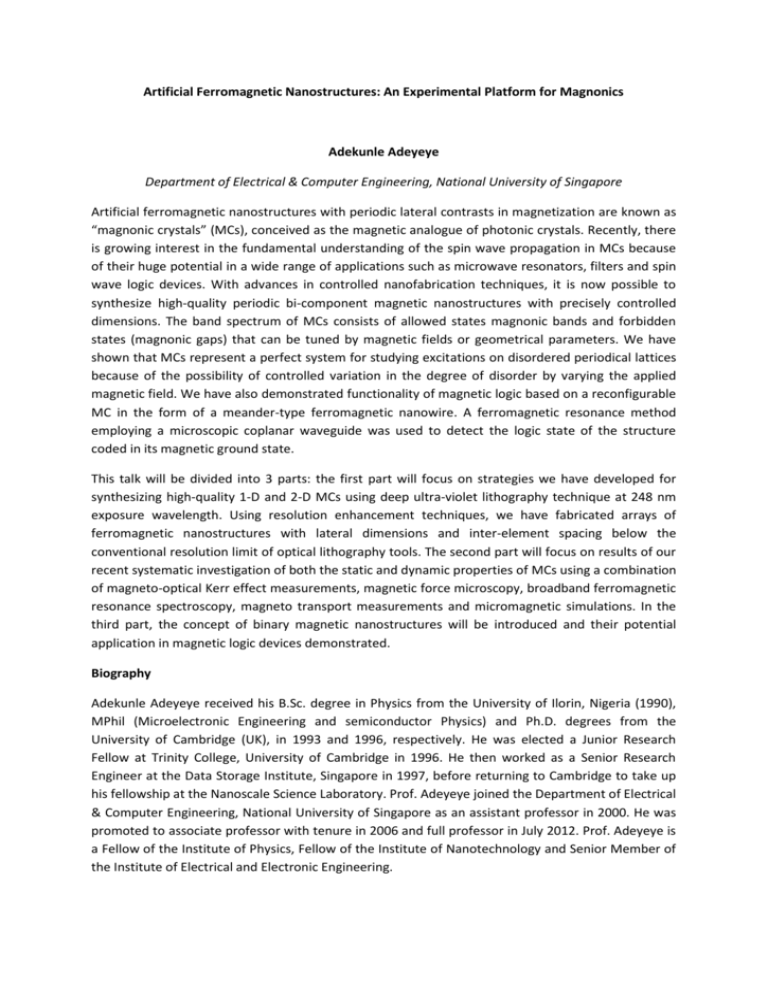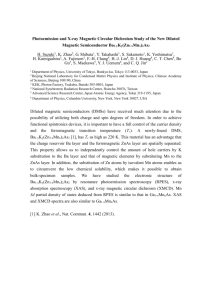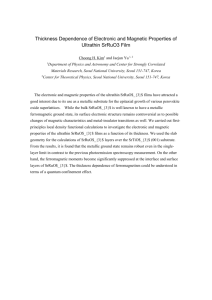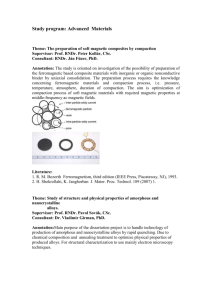Prof. Adekunle Adeyeye - abstract and biography
advertisement

Artificial Ferromagnetic Nanostructures: An Experimental Platform for Magnonics Adekunle Adeyeye Department of Electrical & Computer Engineering, National University of Singapore Artificial ferromagnetic nanostructures with periodic lateral contrasts in magnetization are known as “magnonic crystals” (MCs), conceived as the magnetic analogue of photonic crystals. Recently, there is growing interest in the fundamental understanding of the spin wave propagation in MCs because of their huge potential in a wide range of applications such as microwave resonators, filters and spin wave logic devices. With advances in controlled nanofabrication techniques, it is now possible to synthesize high-quality periodic bi-component magnetic nanostructures with precisely controlled dimensions. The band spectrum of MCs consists of allowed states magnonic bands and forbidden states (magnonic gaps) that can be tuned by magnetic fields or geometrical parameters. We have shown that MCs represent a perfect system for studying excitations on disordered periodical lattices because of the possibility of controlled variation in the degree of disorder by varying the applied magnetic field. We have also demonstrated functionality of magnetic logic based on a reconfigurable MC in the form of a meander-type ferromagnetic nanowire. A ferromagnetic resonance method employing a microscopic coplanar waveguide was used to detect the logic state of the structure coded in its magnetic ground state. This talk will be divided into 3 parts: the first part will focus on strategies we have developed for synthesizing high-quality 1-D and 2-D MCs using deep ultra-violet lithography technique at 248 nm exposure wavelength. Using resolution enhancement techniques, we have fabricated arrays of ferromagnetic nanostructures with lateral dimensions and inter-element spacing below the conventional resolution limit of optical lithography tools. The second part will focus on results of our recent systematic investigation of both the static and dynamic properties of MCs using a combination of magneto-optical Kerr effect measurements, magnetic force microscopy, broadband ferromagnetic resonance spectroscopy, magneto transport measurements and micromagnetic simulations. In the third part, the concept of binary magnetic nanostructures will be introduced and their potential application in magnetic logic devices demonstrated. Biography Adekunle Adeyeye received his B.Sc. degree in Physics from the University of Ilorin, Nigeria (1990), MPhil (Microelectronic Engineering and semiconductor Physics) and Ph.D. degrees from the University of Cambridge (UK), in 1993 and 1996, respectively. He was elected a Junior Research Fellow at Trinity College, University of Cambridge in 1996. He then worked as a Senior Research Engineer at the Data Storage Institute, Singapore in 1997, before returning to Cambridge to take up his fellowship at the Nanoscale Science Laboratory. Prof. Adeyeye joined the Department of Electrical & Computer Engineering, National University of Singapore as an assistant professor in 2000. He was promoted to associate professor with tenure in 2006 and full professor in July 2012. Prof. Adeyeye is a Fellow of the Institute of Physics, Fellow of the Institute of Nanotechnology and Senior Member of the Institute of Electrical and Electronic Engineering.







